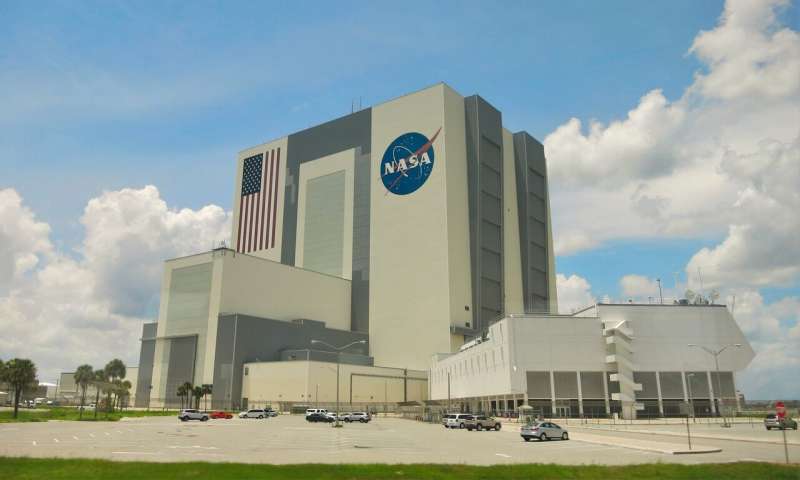ULA could fly dummy payload on next Vulcan launch if Dream Chaser is delayed
Monday, 13 May 2024 18:28

Third time could prove lucky for aurora viewers around the world
Monday, 13 May 2024 18:21 Anyone who missed the dazzling auroras dancing across night skies earlier this weekend will get another chance Sunday evening, as the powerful geomagnetic storm hitting the Earth is expected to intensify yet again.
"Several intense Coronal Mass Ejections are still anticipated to reach the Earth's outer atmosphere by later today," the US National Weather Service said.
Those ejections -
Anyone who missed the dazzling auroras dancing across night skies earlier this weekend will get another chance Sunday evening, as the powerful geomagnetic storm hitting the Earth is expected to intensify yet again.
"Several intense Coronal Mass Ejections are still anticipated to reach the Earth's outer atmosphere by later today," the US National Weather Service said.
Those ejections - SpaceX launches 23 Starlink satellites from Florida
Monday, 13 May 2024 16:32 SpaceX launched 23 Starlink satellites into low-Earth orbit from the Cape Canaveral Space Force Station on Sunday night, bringing the total number of Starlink satellites in orbit to just over 6,000.
This was the 15th mission for the reusable booster rocket, which launches the spacecraft into orbit, largely under the power of a million pounds of rocket-grade kerosene. Nine of its launche
SpaceX launched 23 Starlink satellites into low-Earth orbit from the Cape Canaveral Space Force Station on Sunday night, bringing the total number of Starlink satellites in orbit to just over 6,000.
This was the 15th mission for the reusable booster rocket, which launches the spacecraft into orbit, largely under the power of a million pounds of rocket-grade kerosene. Nine of its launche Where is the Best Place to Buy Used Books?
Monday, 13 May 2024 16:32 An average student's battle to acquire a textbook at a reasonable price is the hardship he/she has to go through every day. Baffling if it is possible to get the textbooks for the semester without any fortune to waste. There is no doubt in my mind that the top spot of receiving money is not the most expensive one and it helps you to start the year off smoothly with no financial troubles.
An average student's battle to acquire a textbook at a reasonable price is the hardship he/she has to go through every day. Baffling if it is possible to get the textbooks for the semester without any fortune to waste. There is no doubt in my mind that the top spot of receiving money is not the most expensive one and it helps you to start the year off smoothly with no financial troubles. SpaceX shows off its new extravehicular activity suit
Monday, 13 May 2024 15:24
In February 2022, SpaceX and entrepreneur/philanthropist Jared Isaacman (commander of the Inspiration4 mission) announced they were launching a new program to "rapidly advance human spaceflight capabilities" while supporting important charitable and humanitarian causes here on Earth. It's called the Polaris Program.
In a recent press release, SpaceX revealed the spacesuits its Polaris astronauts will be wearing and described the research that the crews will conduct during the program's three human spaceflight missions—the first of which is scheduled to launch this summer.
These missions will build on the company's experience with NASA's Commercial Crew Delivery (CCD) program, where NASA certified SpaceX's Crew Dragon vehicle to transport crews to the International Space Station (ISS). According to the company's press statement, the new suits are an evolution of the Intravehicular Activity (IVA) suit currently used by Dragon crews. This included the crew of the Demo-2 mission, which validated the flight system and was the first crewed mission to take off from U.S.
FAA initiates environmental impact study for SpaceX Starship launches from Kennedy Space Center
Monday, 13 May 2024 14:48
SpaceX's plans to build a Starship launch complex at Kennedy Space Center are moving closer to reality even as it potentially takes over a launch site from neighboring Cape Canaveral Space Force Station.
The Federal Aviation Administration said it was beginning an Environmental Impact Statement for Starship launches from KSC's Launch Complex 39-A. SpaceX had already built the beginning of a Starship launch tower adjacent to its existing pad that supports Falcon 9 and Falcon Heavy launches.
Noticeable work on that new launch tower stopped in late 2022 as SpaceX shifted focus to develop its Starship and Super Heavy rocket from its Texas test launch site where it has managed three flights with varying degrees of success. The powerful rocket produces more than 16 million pounds of thrust at liftoff, nearly double that of NASA's Space Launch System rocket for its Artemis program.
The most recent launch in March saw the Starship upper stage finally achieve orbit before it burned up on reentry over the Indian Ocean while the Super Heavy booster crashed into the Gulf of Mexico.
NASA and JAXA to operate XRISM as-is despite instrument issue
Monday, 13 May 2024 10:39

Second night of auroras seen 'extreme' solar storm
Sunday, 12 May 2024 18:50 Auroras lit up skies across swaths of the planet for the second night in a row on Saturday, after already dazzling Earthlings from the United States to Tasmania to the Bahamas the day before.
A powerful solar storm - which could continue into Sunday - has triggered spectacular celestial shows usually confined to the far northern reaches of the planet, hence their nickname of the "northern
Auroras lit up skies across swaths of the planet for the second night in a row on Saturday, after already dazzling Earthlings from the United States to Tasmania to the Bahamas the day before.
A powerful solar storm - which could continue into Sunday - has triggered spectacular celestial shows usually confined to the far northern reaches of the planet, hence their nickname of the "northern Estonia summons Russian envoy over GPS jamming
Sunday, 12 May 2024 18:50 Estonia on Wednesday summoned Russia's charge d'affaires over GPS interference, which the NATO member said was Russian "hybrid activity" that had disrupted civilian air traffic.
Estonia and fellow Baltic states Latvia and Lithuania last month warned that widespread Russian GPS jamming increased the threat of an aviation accident.
"Today we summoned (the) Russian charge d'affaires over GP
Estonia on Wednesday summoned Russia's charge d'affaires over GPS interference, which the NATO member said was Russian "hybrid activity" that had disrupted civilian air traffic.
Estonia and fellow Baltic states Latvia and Lithuania last month warned that widespread Russian GPS jamming increased the threat of an aviation accident.
"Today we summoned (the) Russian charge d'affaires over GP Manta Ray UUV moves closer to operational readiness after successful tests
Sunday, 12 May 2024 18:50 In February and March 2024, the Manta Ray uncrewed underwater vehicle (UUV) prototype, developed by Northrop Grumman, underwent comprehensive in-water testing off Southern California's coast. The tests assessed the UUV's hydrodynamic performance, including submerged operations employing its various propulsion and steering modes such as buoyancy, propellers, and control surfaces.
"Our succe
In February and March 2024, the Manta Ray uncrewed underwater vehicle (UUV) prototype, developed by Northrop Grumman, underwent comprehensive in-water testing off Southern California's coast. The tests assessed the UUV's hydrodynamic performance, including submerged operations employing its various propulsion and steering modes such as buoyancy, propellers, and control surfaces.
"Our succe Princeton physicists reveal the microscopic basis of a new form of quantum magnetism
Sunday, 12 May 2024 18:50 Not all magnets are the same. When we think of magnetism, we often think of magnets that stick to a refrigerator's door. For these types of magnets, the electronic interactions that give rise to magnetism have been understood for around a century, since the early days of quantum mechanics. But there are many different forms of magnetism in nature, and scientists are still discovering the mechani
Not all magnets are the same. When we think of magnetism, we often think of magnets that stick to a refrigerator's door. For these types of magnets, the electronic interactions that give rise to magnetism have been understood for around a century, since the early days of quantum mechanics. But there are many different forms of magnetism in nature, and scientists are still discovering the mechani AI Ethics in the Digital Afterlife: Safeguards Needed to Avoid Unwanted AI "Hauntings"
Sunday, 12 May 2024 18:50 The prospect of interacting with digital avatars of deceased individuals, facilitated by advancements in artificial intelligence, poses potential psychological risks, according to a new study from the University of Cambridge. Researchers at the Leverhulme Centre for the Future of Intelligence have raised concerns about the emerging field of "digital afterlife," where AI-powered chatbots, known a
The prospect of interacting with digital avatars of deceased individuals, facilitated by advancements in artificial intelligence, poses potential psychological risks, according to a new study from the University of Cambridge. Researchers at the Leverhulme Centre for the Future of Intelligence have raised concerns about the emerging field of "digital afterlife," where AI-powered chatbots, known a Using MRI, engineers have found a way to detect light deep in the brain
Sunday, 12 May 2024 18:50 Scientists often label cells with proteins that glow, allowing them to track the growth of a tumor, or measure changes in gene expression that occur as cells differentiate.
While this technique works well in cells and some tissues of the body, it has been difficult to apply this technique to image structures deep within the brain, because the light scatters too much before it can be detect
Scientists often label cells with proteins that glow, allowing them to track the growth of a tumor, or measure changes in gene expression that occur as cells differentiate.
While this technique works well in cells and some tissues of the body, it has been difficult to apply this technique to image structures deep within the brain, because the light scatters too much before it can be detect 



